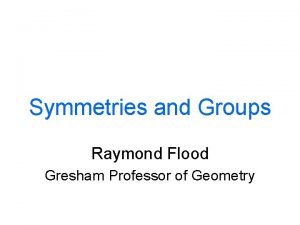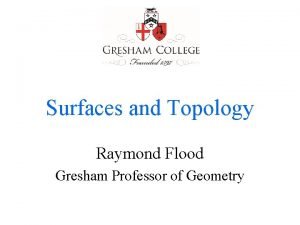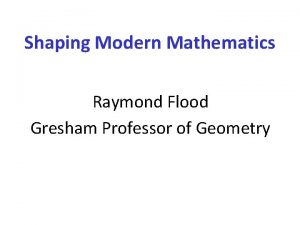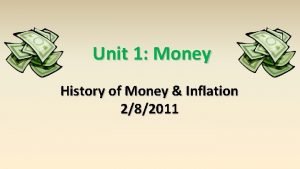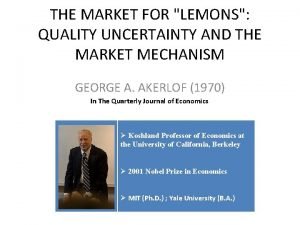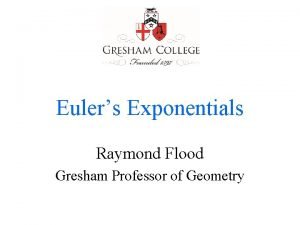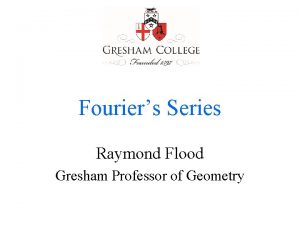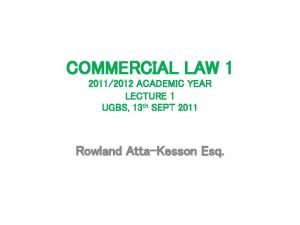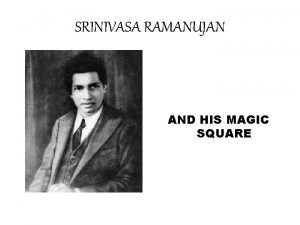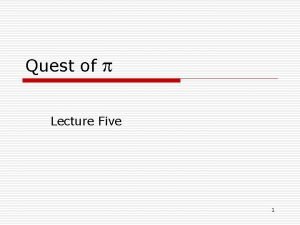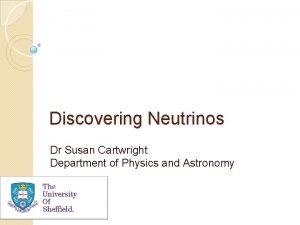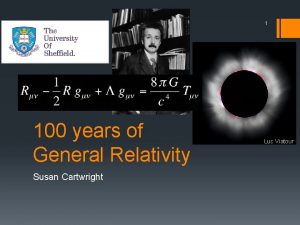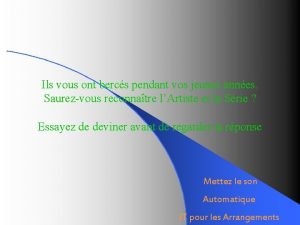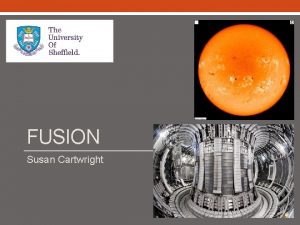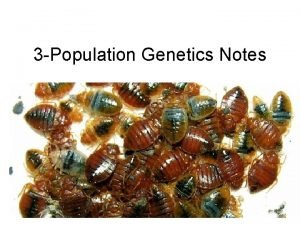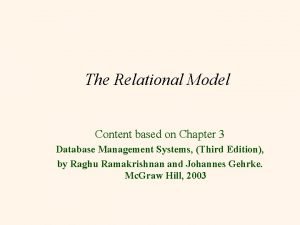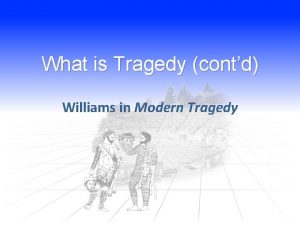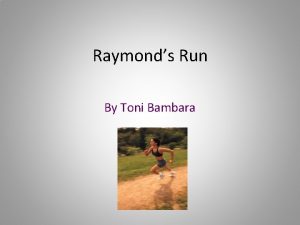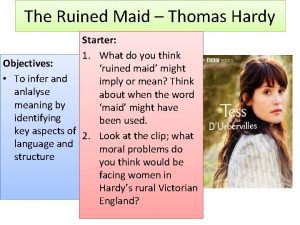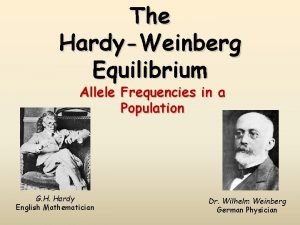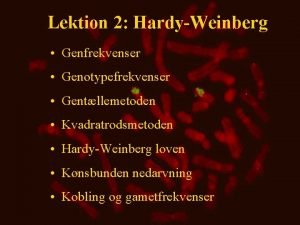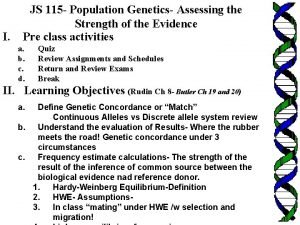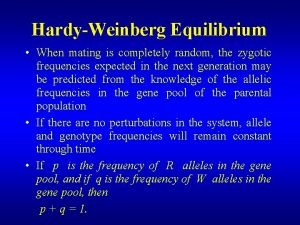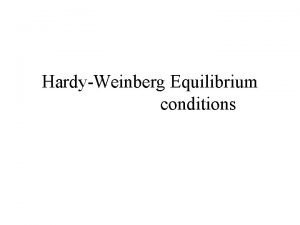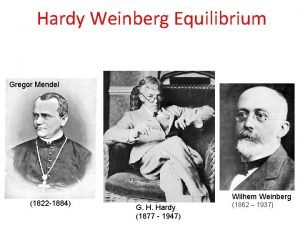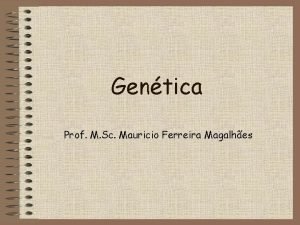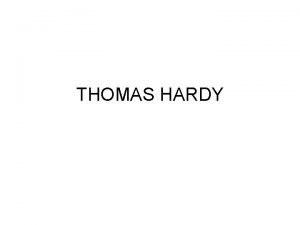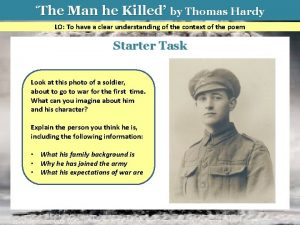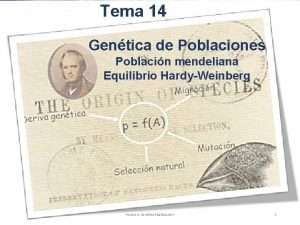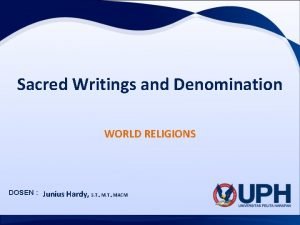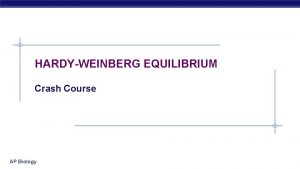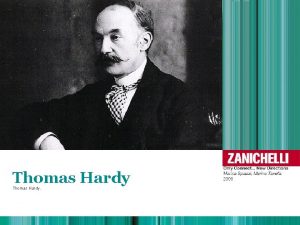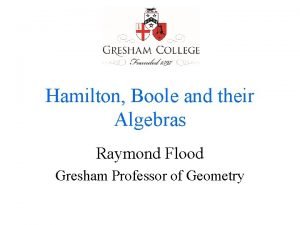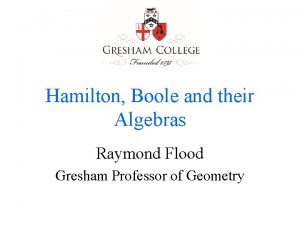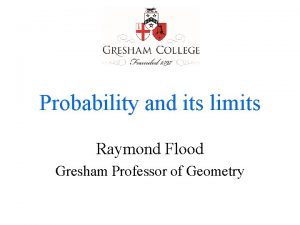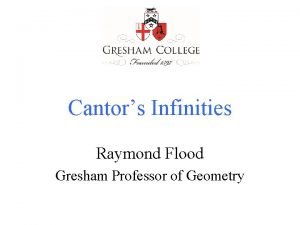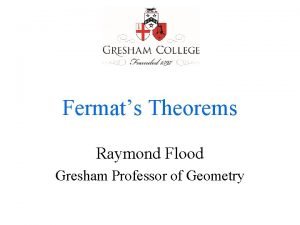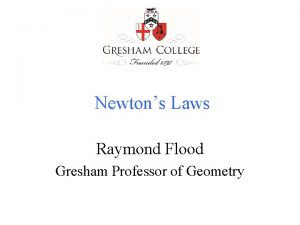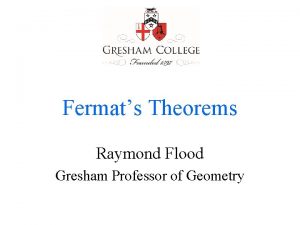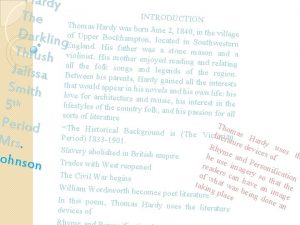Hardy Littlewood Ramanujan and Cartwright Raymond Flood Gresham





















































- Slides: 53

Hardy, Littlewood, Ramanujan and Cartwright Raymond Flood Gresham Professor of Geometry

Godfrey Harold Hardy, 1877– 1947, is on the left with John Edensor Littlewood, 1885– 1977, at Trinity College, Cambridge Srinivasa Ramanujan 1887– 1920

Hardy in his early twenties

It is curious to note how the character of the criticisms I have had to meet has changed. I was too meticulous and pedantic for my pupils of fifteen years ago: I am altogether too popular for the Trinity scholar of to-day. I need hardly say that I find such criticisms very gratifying, as the best evidence that the book has to some extent fulfilled the purpose with which it was written. https: //www. gutenberg. org/files/38769 -pdf. pdf

Hardy-Weinberg Law Letter to Science in 1908 Mendelian Proportions in a Mixed Population In a word, there is not the slightest foundation for the idea that a dominant character should show a tendency to spread over a whole population, or that a recessive should tend to die out.

Setting things up

What is the probability that a parent contributes an A gene to its child? •

• What now are the probabilities of the three genetic types in the next generation?

These probabilities of the different gene types in the second generation are not the same as the probabilities of the different gene types in the first generation AA First generation Second generation Aa aa

“…whatever the value of p, q and r may be, the distribution will in any case continue unchanged after the second generation. ” AA First generation Second generation Third generation Aa aa

“…whatever the value of p, q and r may be, the distribution will in any case continue unchanged after the second generation. ” AA Aa aa First generation Second generation Third generation Exercise: Show that if in the first generation the proportions of the gene types are 3 : 6 : 1 then in the second generation the proportions will be 9 : 12 : 4 and that this will remain the case in the third and all later generations.

Hardy was President of the London Mathematical Society from 1926 to 1928 and again from 1939 to 1941

John Edensor Littlewood (1885– 1977) Littlewood in 1907

One day I was playing round with this, and a ghost of an idea entered my mind of making r, the number of differentiations, large. At that moment the spring cleaning that was in progress reached the room I was working in, and there was nothing for it but to go walking for 2 hours, in pouring rain.

Preparation Incubation Illumination Verification

On looking back this time seems to me to mark my arrival at a reasonably assured judgment and taste, the end of my ‘education’. I soon began my 35 -year collaboration with Hardy.

Hardy and Littlewood at Trinity College, Cambridge

Nowadays, there are only three really great English mathematicians, Hardy, Littlewood, and Hardy– Littlewood.

Axioms of Collaboration! 1. When one wrote to the other it did not matter whether what they wrote was right or wrong

Axioms of Collaboration! 1. When one wrote to the other it did not matter whether what they wrote was right or wrong 2. When one wrote to the other the recipient was not only under no obligation to answer it but indeed under no obligation even to open it

Axioms of Collaboration! 1. When one wrote to the other it did not matter whether what they wrote was right or wrong 2. When one wrote to the other the recipient was not only under no obligation to answer it but indeed under no obligation even to open it 3. It was better if they did not both work on the same detail

Axioms of Collaboration! 1. When one wrote to the other it did not matter whether what they wrote was right or wrong 2. When one wrote to the other the recipient was not only under no obligation to answer it but indeed under no obligation even to open it 3. It was better if they did not both work on the same detail 4. It did not matter if one of them had not contributed the least bit to the contents of a paper appearing under their joint names

Riemann Hypothesis Do all the solutions of a certain equation have a particular form? Do all the non-trivial zeros of the Riemann Zeta function have real part 1/2? http: //www. claymath. org/millennium-problems/riemannhypothesis


Riemann Zeta function •

Riemann Zeta function •

Riemann Zeta function •

Fundamental Theorem of Arithmetic Every whole number can be written as a product of prime numbers in only one way apart from the order in which they are written. 42 = 2 × 3 × 7 80 = 2 × 2 × 5 22012013 = 19 × 53 × 21859

The Riemann zeta function can be written as an infinite product of expressions which only involve primes •

The Riemann zeta function can be written as an infinite product of expressions which only involve primes •

Riemann Zeta Function •

Riemann Zeta Function •

Riemann Hypothesis All non-trivial zeros lie on the line x = 1/2 Critical strip

Srinivasa Ramanujan 1887– 1920 Bertrand Russell Letter to Lady Ottoline Morrell In Hall I found Hardy and Littlewood in a state of wild excitement, because they believe they have discovered a second Newton, … Hardy has written to the Indian Office and hopes to get the man here at once.

Ramanujan’s first letter to Hardy January 16, 1913 Dear Sir, I beg to introduce myself to you as a clerk in the Accounts Department of the Port Trust Office at Madras on a salary of only £ 20 per annum. I am now about 23 years of age. I have no University education but I have undergone the ordinary school course. After leaving school I have been employing the spare time at my disposal to work at Mathematics. I have not trodden through the conventional regular course followed in a University course, but I am striking out a new path for myself. I have made special investigation of divergent series in general and the results I get are termed by the local mathematicians as startling

Partitions The problem is to find the number of different ways, p(n), of writing a given positive integer, n, as the sum of integers. Example: p(4) = 5 4 has the five partitions 4, 3 + 1, 2 + 2, 2 + 1, 1 +1+1+1 Note that the in the partitions, order does not matter so that 3 + 1 is the same as 1 + 3.

Partitions Example: p(7) = 15 7 6+1 5+2 5+1+1 4+2+1 4+1+1+1 3+2+2 3+3+1 3+2+1+1 3+1+1 2+2+2+1+1+1 2 + 1 + 1+ 1 4+3 1 + 1 + 1 + 1+ 1 By n = 70 the number of partitions has risen to over 4 million and p(200) = 3, 972, 999, 029, 388 which is nearly four thousand billion


I remember once going to see him when he was lying ill at Putney. I had ridden in taxi-cab No. 1729, and remarked that the number seemed to me rather a dull one, and that I hoped it was not an unfavourable omen. “No, ” he replied, “it is a very interesting number; it is the smallest number expressible as a sum of two cubes in two different ways. ” 1729 = 13 + 123 = 93 + 103

I remember once going to see him when he was lying ill at Putney. I had ridden in taxi-cab No. 1729, and remarked that the number seemed to me rather a dull one, and that I hoped it was not an unfavourable omen. “No, ” he replied, “it is a very interesting number; it is the smallest number expressible as a sum of two cubes in two different ways. ” 1729 = 13 + 123 = 93 + 103 London Taxi cab n° 1729. Built in France by Unic, they were the most current taxi cabs in London at the time of the Hardy/Ramanujan anecdote. Image from the "London Vintage Taxi Association" but slightly modified: LF 5795 becomes here LF 1729! © http: //www. christianboyer. com/taxicab/ Taxicab(n) is the smallest number expressible

Bust of Ramunajan at Birla Industrial & Technological Museum (BITM), Kolkata

https: //www. maths. ox. ac. uk/system/files/attachments/GH%20 Hardy. pdf

G. H. Hardy leads a cricket team of Oxford mathematicians during a British Association meeting in 1926: Hardy dubbed this photograph Mathematicians v. The Rest of the World.

Hardy in his room at New College, Oxford A manuscript page from 1930. The main page is in Hardy’s writing and the additions Littlewoods

Waring’s problem Every positive integer can be written as the sum of at most 4 squares, 9 cubes or 19 fourth powers Does this continue for nth powers, and if so how many powers are needed?

Waring’s problem Every positive integer can be written as the sum of at most 4 squares, 9 cubes or 19 fourth powers Does this continue for nth powers, and if so how many powers are needed? David Hilbert proved the answer was yes but the information he could obtain on how many of the powers were needed was weak

Terence Tao was a co-recipient of the 2006 Fields Medal and the 2014 Breakthrough Prize in Mathematics

https: //archive. org/details/AMathematicians. Apology https: //archive. org/details/mathematiciansmi 033496 mbp

G. H. Hardy with his research student Mary Cartwright, later to be the first woman appointed President of the London Mathematical Society Mary Cartwright 1900 – 1998


On International Women's Day 2013, Lisa Jardine, presenting A Point of View, felt it was a particularly appropriate time to blow Dame Mary Cartwright's trumpet on her behalf - for her brilliance as a mathematician, and as one of the founders of the important field of chaos theory.

The case for my life then, or for that of anyone else who has been a mathematician in the same sense in which I have been one, is this: that I have added something to knowledge, and helped others to add more; and that these somethings have a value which differs in degree only, and not in kind, from that of the creations of the great mathematicians, or of any of the other artists, great or small, who have left some kind of memorial behind Apology Conclusion of A Mathematician’s

1 pm on Tuesdays at the Museum of London Einstein’s Annus Mirabilis, 1905 Tuesday 20 October 2015 Hamilton, Boole and their Algebras Tuesday 17 November 2015 Babbage and Lovelace Tuesday 19 January 2016 Gauss and Germain Tuesday 16 February 2016 Hardy, Littlewood and Ramanujan Tuesday 15 March 2016 Turing and von Neumann Tuesday 19 April 2016
 Raymond flood
Raymond flood Professor raymond flood
Professor raymond flood Quickest descent
Quickest descent Gresham's law
Gresham's law Gresham’s law
Gresham’s law Gresham professor of geometry
Gresham professor of geometry Gresham professor of geometry
Gresham professor of geometry Ryder v wombwell
Ryder v wombwell Ramanujan's magic square
Ramanujan's magic square Ramanujan infinite series
Ramanujan infinite series S ramanujan
S ramanujan Ramanujan square box
Ramanujan square box Susan cartwright sheffield
Susan cartwright sheffield Dr susan cartwright
Dr susan cartwright Quantum mechanics
Quantum mechanics Dr susan cartwright
Dr susan cartwright Julian cartwright
Julian cartwright Megan cartwright
Megan cartwright Joe cartwright
Joe cartwright Susan cartwright sheffield
Susan cartwright sheffield P2 2pq q2
P2 2pq q2 P and q in hardy weinberg
P and q in hardy weinberg Gordon condon
Gordon condon Donald d. chamberlin and raymond f. boyce
Donald d. chamberlin and raymond f. boyce Tragedy and contemporary ideas by raymond williams
Tragedy and contemporary ideas by raymond williams Raymond's run text dependent questions and answers
Raymond's run text dependent questions and answers Raymond james stuart
Raymond james stuart Junius hardy
Junius hardy What type of poem is the ruined maid
What type of poem is the ruined maid Hardy-weinberg equilibrium
Hardy-weinberg equilibrium Genfrekvens
Genfrekvens Taxonomic group
Taxonomic group 5 hardy weinberg assumptions
5 hardy weinberg assumptions Hardy weinberg assumptions
Hardy weinberg assumptions Hardy weinberg equilibrium conditions
Hardy weinberg equilibrium conditions Wilhem weinberg
Wilhem weinberg Hardy matematik
Hardy matematik Daltonismo gene
Daltonismo gene Equilibrio hardy weinberg
Equilibrio hardy weinberg Ken hardy tasks of the privileged
Ken hardy tasks of the privileged Thomas hardy at an inn
Thomas hardy at an inn Hardy weinberg assumptions
Hardy weinberg assumptions Hardi vajnbergov
Hardi vajnbergov Judith wright magpies
Judith wright magpies Emma gifford
Emma gifford The man he killed
The man he killed The man he killed
The man he killed Terraria trivia
Terraria trivia Desviacion del apareamiento aleatorio
Desviacion del apareamiento aleatorio Junius hardy
Junius hardy Knockhardy chemistry
Knockhardy chemistry Genfrekvens
Genfrekvens Hardy weinberg crash course
Hardy weinberg crash course Hardy weinberg oefenen
Hardy weinberg oefenen
